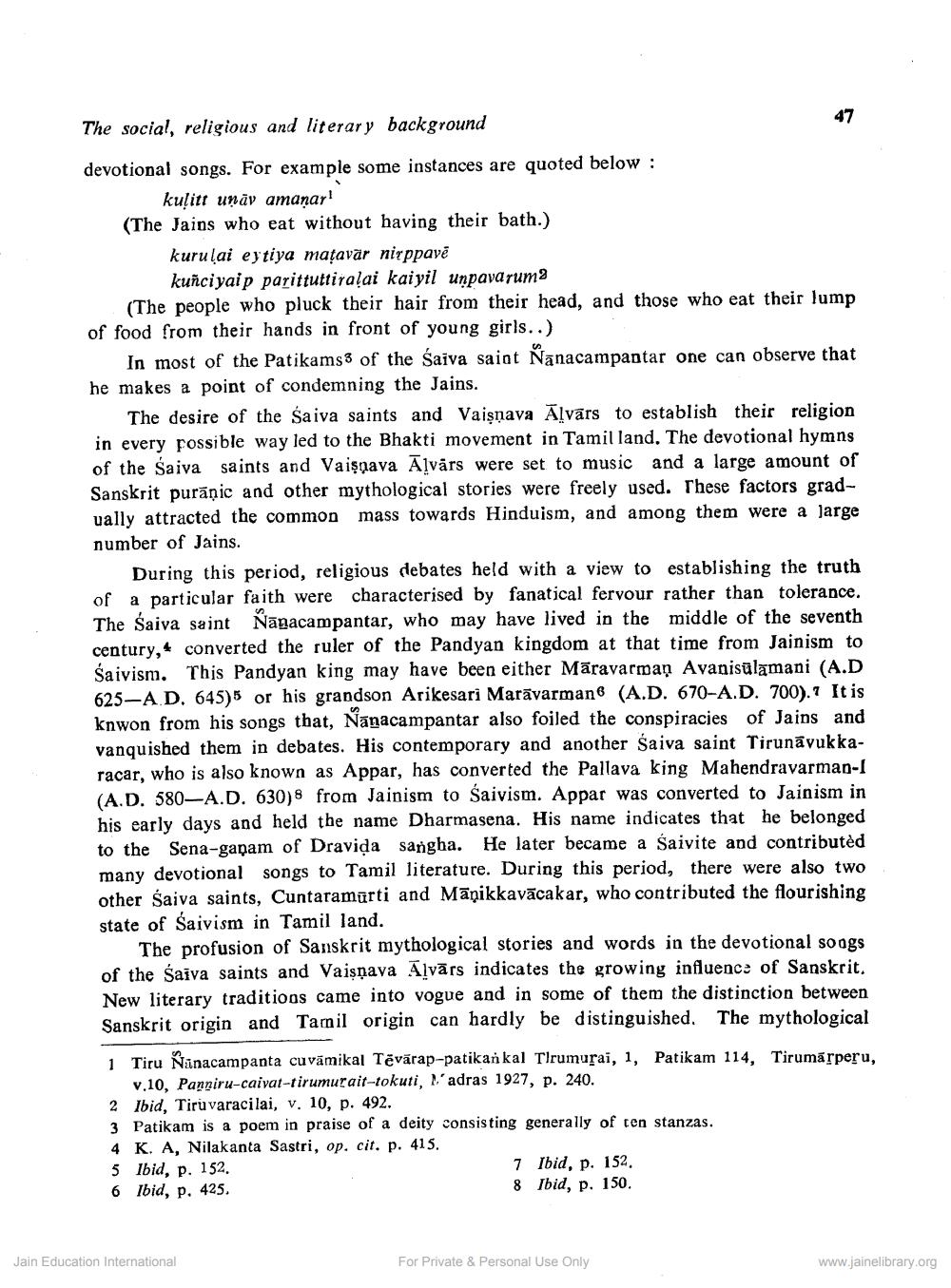________________
The social, religious and literary background
devotional songs. For example some instances are quoted below :
kuļitt unāv amanar (The Jains who eat without having their bath.)
kurulai eytiya mațavar nirppavē
kuñciyaip parittuttiraļai kaiyil unpavarum2 (The people who pluck their hair from their head, and those who eat their lump of food from their hands in front of young girls..)
In most of the Patikams 3 of the saiva saiat Nanacampantar one can observe that he makes a point of condemning the Jains.
The desire of the Saiva saints and Vaişnava Aļvārs to establish their religion in every possible way led to the Bhakti movement in Tamil land. The devotional hymns of the Saiva saints and Vaisnava Alvārs were set to music and a large amount of Sanskrit purāņic and other mythological stories were freely used. These factors gradually attracted the common mass towards Hinduism, and among them were a large number of Jains.
During this period, religious debates held with a view to establishing the truth of a particular faith were characterised by fanatical fervour rather than tolerance. The Saiva saint Napacampantar, who may have lived in the middle of the seventh century, 4 converted the ruler of the Pandyan kingdom at that time from Jainism to Saivism, This Pandyan king may have been either Māravarman Ayanisulamani (A.D 625-AD. 645)5 or his grandson Arikesari Marāvarman (A.D. 670-A.D. 700). It is knwon from his songs that, Nanacampantar also foiled the conspiracies of Jains and vanquished them in debates. His contemporary and another saiva saint Tirunavukkaracar, who is also known as Appar, has converted the Pallava king Mahendravarman-I (A.D. 580—A.D. 630)8 from Jainism to saivism. Appar was converted to Jainism in his early days and held the name Dharmasena. His name indicates that he belonged to the Sena-ganam of Dravida sangha. He later became a Saivite and contributed many devotional songs to Tamil literature. During this period, there were also two other Saiva saints, Cuntaramūrti and Māņikkavācakar, who contributed the flourishing state of Saivism in Tamil land.
The profusion of Sanskrit mythological stories and words in the devotional songs of the saiva saints and Vaişņava Alvārs indicates the growing influence of Sanskrit. New literary traditions came into vogue and in some of them the distinction between Sanskrit origin and Tamil origin can hardly be distinguished. The mythological
1 Tiru Nanacampanta cuvāmikal Tēvārap-patikan kal Tirumurai, 1, Patikam 114, Tirumárperu,
v.10, Panniru-caivat-tirumurait-tokuti, l'adras 1927, p. 240. 2 Ibid, Tiruvaracilai, v. 10, p. 492. 3 Patikam is a poem in praise of a deity consisting generally of ten stanzas. 4 K. A, Nilakanta Sastri, op. cit. p. 415. 5 lbid, p. 152.
7 Ibid, p. 152. 6 Ibid, p. 425.
8 Ibid, p. 150.
Jain Education International
For Private & Personal Use Only
www.jainelibrary.org




